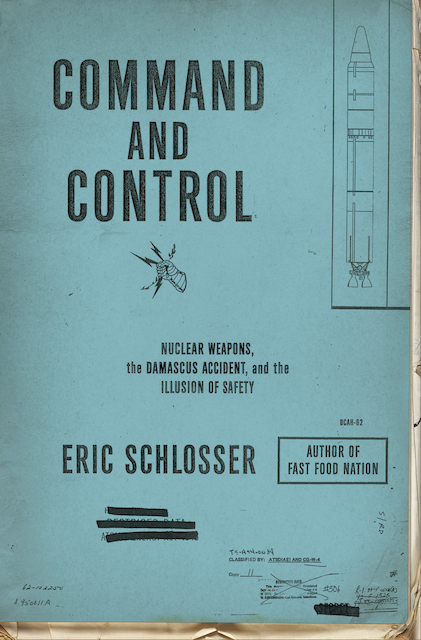The first atomic bombs exploded in pillars of radioactive fire—near Socorro, in Hiroshima, in Nagasaki. The bombs’ fires died down, their radiation remained, and then we built more. The United States set up a factory here in Albuquerque and built them by the hundreds. The Soviet Union built them, too. Both of these countries also built hydrogen bombs—even deadlier weapons—which used the atom-splitting process to create fusion, the same thing that powers the sun. The US and the USSR found themselves in an arms race, each fearfully trying to outdo the other, and a major result of that was an aging stockpile of thousands of nuclear weapons, every one expensive and laborious to maintain, every one susceptible to serious systemic and human error, every one a potential holocaust and maybe half of them stored right here, in our city, where we live.Best-known for his New York Times-bestselling examination of fast food in America, Fast Food Nation, author Eric Schlosser has written a new book about the tenuous safety of America’s nuclear arsenal—Command and Control: Nuclear Weapons, the Damascus Accident, and the Illusion of Safety—out now from The Penguin Press. Living in New Mexico, most of us are probably familiar with the basic details of the birth of the atom bomb—Einstein, Oppenheimer, Los Alamos and so on—but what about the bomb’s adolescence? What about when the bomb grew up? Command and Control picks up where most histories of the subject leave off, exploring the proliferation of nuclear weapons, the apparent impossibility of maintaining these devices without accident and many instances in which one of these deadly things nearly went off unintentionally. In particular the book tells of a 1980 accident in a Damascus, Arkansas missile silo, in which a dropped socket from a socket wrench knocked a hole in a fuel tank and led to an epic disaster. Schlosser takes that story and surrounds it with the context needed to understand it—a context that includes hundreds of other accidents, a discussion of the limitations of our now-decades-old nuclear technology, a history of the Cold War and a lot, a lot, a lot about Albuquerque. “Everyone in America should be thinking about these issues,” said Schlosser in an interview. “People in Albuquerque, even more so. You need to be aware. You need to be involved. You need to know what’s in the hills.”Tech Area II, a guard-tower-ringed portion of Sandia National Laboratories in Albuquerque, was America’s first atomic bomb factory, and when the bombs were completed, they were taken to Site Able, a storage facility inside four hollowed-out foothills at the northern end of the Manzano Mountains, just east of town. Locally, most of us call that site the Four Hills, and a shopping plaza and a movie theater share the name. Even now about half the country’s nuclear weapons—more than 2,000 of them—are stored on the edge of town, quietly aging in what’s called the Kirtland Underground Munitions Storage Complex. Oh, and in 2010, literally the entire squadron who worked there lost their official certification after receiving an “unsatisfactory” rating for their care of these temperamental weapons. That happened. Reading Command and Control may not make you feel any better about all of this—but it will leave you more informed and better able to take part in this ongoing and increasingly urgent discussion. What do we do with these improbably lethal devices? How do we keep these weapons safe from time, terrorism and sheer bad luck? “The first thing that needs to be done is the decision-making needs to be removed from a small group of policy makers,” says Schlosser. “It needs to be democratized. There needs to be a national debate. People need to be aware. We need a movement.”Schlosser spent six years researching and writing about this topic, and it shows: More than one sixth of the book’s page-count is endnotes. “In the same way the Government is all about secrecy and suppressing this information, I wanted to provide a roadmap,” he says. “I wanted transparency.” Schlosser has a background as a playwright and screenwriter, and that’s evident in his writing style—it’s very plain, crisp and unadorned—which works for a book like Command and Control with so much going on inside it. Few distinct characters emerge, but the mass of humanity moves through its pages like a tide, lapping at the shores of North America and Europe, swirling around unprecedented weapons, doomsday scenarios, island-annihilating tests and near-calamities. As readers, this allows us to see the insanity of what we are doing, not only to others but to ourselves, as a species. It lets us see that these weapons, should they ever see use, would doubtlessly affect us all. And it shows us how little individuals like ourselves typically matter to the masters of war.“What’s terrible is you could not have an issue of more fundamental existential significance, and it was totally politicized by the Democrats, and then totally politicized by the Republicans,” says Schlosser. Command and Control reveals politicians of every stripe using nuclear fears to their advantage—collecting votes as they speak of Mutually Assured Destruction, nuclear winter and the end of everything. The results, of course, were decades of fear and anxiety. And: those thousands of improbably toxic weapons, in Albuquerque and elsewhere, requiring constant attention just to keep them from going off. This Friday, Sept. 27, at 7pm, Schlosser will be in Albuquerque for a Bookworks-sponsored reading, discussion and signing at The National Museum of Nuclear Science and History (601 Eubank NE). His book is well worth reading, packed with uncommon information and of extreme relevance to us all—and the event is only $5. Come on out, and take part in what’s certain to be a lively discussion. “I’m a great believer in technology,” Schlosser says. “And I love using all kinds of technology. But I also believe in humility. And we have to be careful.”
Arts Feature
Listen to our atomic playlist!
Eric Schlosser Discusses Command and ControlFriday, Sept. 27, 7pmNational Museum of Nuclear Science and History601 Eubank NETickets: $5344-8139, bkwrks.com













